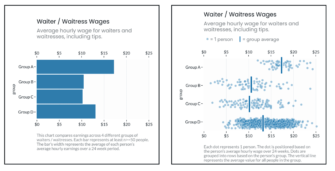Data Visualization 101: Bar Charts Suck
We do a lot of data visualization in the fundraising world. Bar charts are stock in trade, built into every off the shelf product out there. We use them and I hate them. Why?
This comparison courtesy of a company called 3iap and a study they ran with academics nails the issues with the good ol’ bar chart. For starters, I suppose 4 averages are better than one as all averages hide a lot and are often misleading. But, breaking the overall average into 4 as the chart on the left does hardly corrects for all the built-in bias.
And a picture being worth a thousand words is only, wait for it, that’s right, an average. I’d say the chart on the left is maybe 250 words and the one on the right is 10x that.

Here are the issues with the bar chart compared to the Jitter Plots (right).
- The bar chart has zero uncertainty built into it – i.e. spread and variance around the mean is missing. The Jitter Plot shows that there are differences within each bar.
- Bar charts are asymmetric and have a within bar bias because all the “ink” is between 0 and the average. This bias means people assume everybody lives to the left of the end of the bar. The Jitter plots are symmetric showing the full distribution around the mean, vertical bar.
- Bar charts don’t communicate sample size, the Jitter plot does.
Why does this matter? People draw a lot of mistaken inferences from visuals that hide stuff. In experiments people were more likely to think Group C people in the bar were lazier than the exact same Group C people shown in the Jitter plot.
Why? The certainty of the bar chart conveys a sameness of the people living in that bar and that sameness makes folks more likely to think the difference in outcome is on them.
Realize there was no context given here, just showing two charts with the titles and axis labeling you see. It’s impossible to know if the outcome differences are structural (e.g. Group C and B work in fast food diners and the other two bars work in higher end restaurants) or people specific.
But, the picture starts to tell a story instantly and we fill in the gaps, often ignorantly.
Kevin


